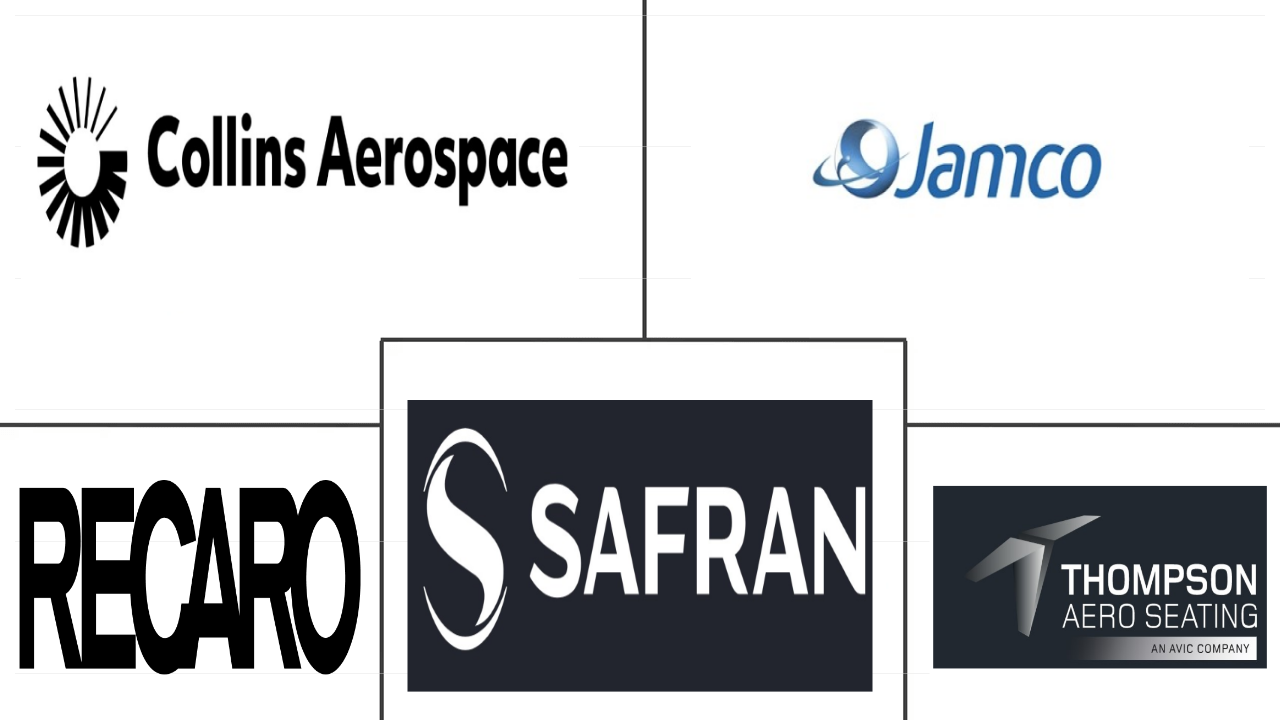Market Size of asia-pacific commercial aircraft cabin seating Industry
| Icons | Lable | Value |
|---|---|---|
|
|
Study Period | 2017 - 2030 |
|
|
Market Size (2024) | USD 0.83 Billion |
|
|
Market Size (2030) | USD 1.53 Billion |
|
|
Largest Share by Aircraft Type | Narrowbody |
|
|
CAGR (2024 - 2030) | 10.63 % |
|
|
Largest Share by Country | China |
|
|
Market Concentration | Medium |
Major Players |
||

|
||
|
*Disclaimer: Major Players sorted in no particular order |
Asia-Pacific Commercial Aircraft Cabin Seating Market Analysis
The Asia-Pacific Commercial Aircraft Cabin Seating Market size is estimated at 0.83 billion USD in 2024, and is expected to reach 1.53 billion USD by 2030, growing at a CAGR of 10.63% during the forecast period (2024-2030).
0.83 Billion
Market Size in 2024 (USD)
1.53 Billion
Market Size in 2030 (USD)
-7.20 %
CAGR (2017-2023)
10.63 %
CAGR (2024-2030)
Largest Market by Aircraft Type
57 %
value share, Narrowbody, 2023
A fleet of narrowbody aircraft adds flexibility in terms of fleet management and helps reduce airlines' operating costs, thereby resulting in its rapid adoption. The demand for premium economy seats in low-cost carriers has increased.
Fastest-Growing Market by Aircraft Type
11.23 %
Projected CAGR, Widebody, 2024-2030
The introduction of new routes in Asia-Pacific has propelled the widebody segment, with airlines focusing on improving passenger comfort.
Largest Market by Cabin Class
55.21 %
value share, Business and First Class, 2023
The increasing number of business class seats with a surge in the number of travelers in business aviation boosted the category's growth.
Largest Market by Country
52.37 %
value share, China, 2023
The growing passenger aviation sector and Chinese airlines' fleet expansion plans boosted the growth of the country’s cabin seating market.
Leading Market Player
33.99 %
market share, Safran, 2022

Safran dominates the Asia-Pacific cabin seating market with a strong product portfolio of cabin seats for passenger aircraft in the region. The company provides seats for the economy, premium economy, business, and first classes.
The adoption of narrowbody aircraft in the longer-haul routes by the airlines in Asia-Pacific has increased
- By body type, passenger aircraft have been segmented into narrowbody and widebody. The narrowbody aircraft segment dominated the market in terms of the number of deliveries, with 2,460+ deliveries during 2017-2022. In 2020, the overall passenger aircraft category, including narrowbody and widebody, witnessed a decline of 35% in the region. New aircraft orders were also affected by delays by airline companies due to travel restrictions on domestic and international routes.
- Airlines in Asia-Pacific are using narrowbody aircraft more frequently on longer routes, facilitating the introduction of ergonomic seats in the market. For instance, Asiana Airlines and Korean Air are working to improve the level of comfort and overall experience during the flight by implementing ergonomic design, individually adjustable calf rests, and privacy features. Air Premier, the first hybrid airline in South Korea, also offers full-service amenities and low-cost air travel through its widebody aircraft fleet. The airline equipped its B787-9 fleet with Recaro’s PL3530 Premium Economy Class and CL3710 Economy Class seats. The Indian aviation market is dominated by low-cost carriers like IndiGo, SpiceJet, and Go First, which operate a fleet of only narrowbody aircraft. Full-service carriers like Air India and Vistara have a mixed fleet of narrowbody and widebody aircraft.
- An enhanced seating structure with more developed space is becoming highly preferred among travelers. During 2023-2030, around 5,000+ aircraft are expected to be delivered in the region. Through their huge orders for narrowbody and widebody aircraft, these airlines are projected to drive the growth of commercial aircraft seats during the forecast period.
China will witness the highest growth in the Asia-Pacific
- The Asia-Pacific region is expected to become one of the fastest-growing commercial aircraft cabin seating markets during the forecast period. Despite the impact of the pandemic on the region's aviation industry, domestic air passenger traffic witnessed gradual growth in 2021. The region accounted for 27.5% of the global air passenger traffic in 2021.
- The rising per capita income due to increased economic and infrastructure development aided the growth of air passengers. It also supported the fleet expansion plans of domestic and regional airlines.
- In the past few years, major countries in the region, like China, India, and Japan, witnessed a rapid increase in passenger traffic, resulting in large orders for new aircraft from airlines operating in the region. China drives the commercial aviation market in the region, one of the largest global aviation markets.
- The growing number of deliveries of new commercial passenger aircraft positively drove the growth of the region's commercial aircraft cabin seating market. In 2021, Boeing delivered 91 aircraft to the region, while Airbus delivered 30% of its aircraft.
- The latest generation aircraft seats are made from non-metallic materials and lightweight designs to reduce fuel expenses and increase the aircraft's sustainability. The demand for seats with enhanced features and technological convenience is increasing, which may boost the market's expansion in the future. For instance, Thompson Aero Seating launched the next-generation VantageXL, a business-class suite with a multi-function bi-fold table, a PED holder, and improved console surface space.
Asia-Pacific Commercial Aircraft Cabin Seating Industry Segmentation
Narrowbody, Widebody are covered as segments by Aircraft Type. China, India, Indonesia, Japan, Singapore, South Korea are covered as segments by Country.
- By body type, passenger aircraft have been segmented into narrowbody and widebody. The narrowbody aircraft segment dominated the market in terms of the number of deliveries, with 2,460+ deliveries during 2017-2022. In 2020, the overall passenger aircraft category, including narrowbody and widebody, witnessed a decline of 35% in the region. New aircraft orders were also affected by delays by airline companies due to travel restrictions on domestic and international routes.
- Airlines in Asia-Pacific are using narrowbody aircraft more frequently on longer routes, facilitating the introduction of ergonomic seats in the market. For instance, Asiana Airlines and Korean Air are working to improve the level of comfort and overall experience during the flight by implementing ergonomic design, individually adjustable calf rests, and privacy features. Air Premier, the first hybrid airline in South Korea, also offers full-service amenities and low-cost air travel through its widebody aircraft fleet. The airline equipped its B787-9 fleet with Recaro’s PL3530 Premium Economy Class and CL3710 Economy Class seats. The Indian aviation market is dominated by low-cost carriers like IndiGo, SpiceJet, and Go First, which operate a fleet of only narrowbody aircraft. Full-service carriers like Air India and Vistara have a mixed fleet of narrowbody and widebody aircraft.
- An enhanced seating structure with more developed space is becoming highly preferred among travelers. During 2023-2030, around 5,000+ aircraft are expected to be delivered in the region. Through their huge orders for narrowbody and widebody aircraft, these airlines are projected to drive the growth of commercial aircraft seats during the forecast period.
| Aircraft Type | |
| Narrowbody | |
| Widebody |
| Country | |
| China | |
| India | |
| Indonesia | |
| Japan | |
| Singapore | |
| South Korea | |
| Rest of Asia-Pacific |
Asia-Pacific Commercial Aircraft Cabin Seating Market Size Summary
The Asia-Pacific Commercial Aircraft Cabin Seating Market is poised for significant growth, driven by the increasing demand for air travel and the expansion of airline fleets in the region. The market is characterized by a strong preference for narrowbody aircraft, which have dominated deliveries in recent years. Airlines in the region are focusing on enhancing passenger comfort by incorporating ergonomic designs and advanced seating features in their aircraft. The rise of low-cost carriers and the strategic use of narrowbody aircraft on longer routes are contributing to the market's expansion. The region's aviation industry is recovering from the pandemic's impact, with domestic and international air passenger traffic showing robust growth, particularly in major countries like China, India, and Japan. This recovery is fueling the demand for new aircraft and, consequently, for commercial aircraft cabin seating.
The market is expected to experience a steady increase in size, supported by substantial orders for both narrowbody and widebody aircraft. The Asia-Pacific region is anticipated to become one of the fastest-growing markets for commercial aircraft cabin seating, with airlines investing in new, fuel-efficient aircraft to maintain a competitive edge. The demand for lightweight and technologically advanced seating solutions is on the rise, as airlines seek to enhance the passenger experience while optimizing operational efficiency. Major players in the market, such as Collins Aerospace, Jamco Corporation, Recaro Group, Safran, and Thompson Aero Seating, are actively involved in supplying innovative seating solutions to meet the evolving needs of airlines in the region. As the aviation market continues to expand, the Asia-Pacific Commercial Aircraft Cabin Seating Market is set to witness significant growth, driven by the increasing number of aircraft deliveries and the ongoing recovery in air travel demand.
Asia-Pacific Commercial Aircraft Cabin Seating Market Size - Table of Contents
-
1. MARKET SEGMENTATION (includes market size in Value in USD, Forecasts up to 2030 and analysis of growth prospects)
-
1.1 Aircraft Type
-
1.1.1 Narrowbody
-
1.1.2 Widebody
-
-
1.2 Country
-
1.2.1 China
-
1.2.2 India
-
1.2.3 Indonesia
-
1.2.4 Japan
-
1.2.5 Singapore
-
1.2.6 South Korea
-
1.2.7 Rest of Asia-Pacific
-
-
Asia-Pacific Commercial Aircraft Cabin Seating Market Size FAQs
How big is the Asia-Pacific Commercial Aircraft Cabin Seating Market?
The Asia-Pacific Commercial Aircraft Cabin Seating Market size is expected to reach USD 832.19 million in 2024 and grow at a CAGR of 10.63% to reach USD 1.53 billion by 2030.
What is the current Asia-Pacific Commercial Aircraft Cabin Seating Market size?
In 2024, the Asia-Pacific Commercial Aircraft Cabin Seating Market size is expected to reach USD 832.19 million.

